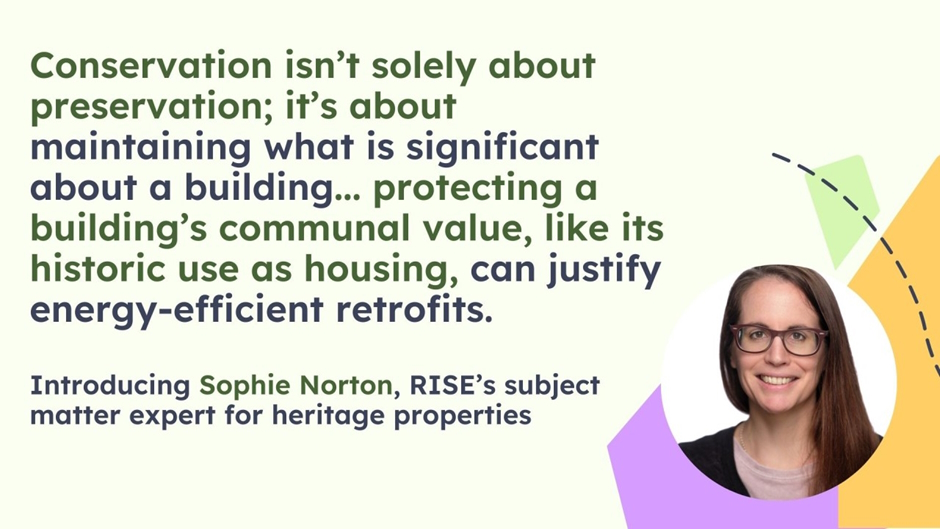T: 01822 851370 E: [email protected]
Visit RSN Survey about life in rural England to find out more.
Retrofitting historic and heritage homes – how conservation and retrofit goals can align
 Carrying out retrofit measures on historic or heritage properties can be a more complicated process than on newer homes. But the benefits can be substantial. Sophie Norton, Sustainability Consultant at Turner & Townsend, and the RISE subject matter expert for historic and heritage properties explains how.
Carrying out retrofit measures on historic or heritage properties can be a more complicated process than on newer homes. But the benefits can be substantial. Sophie Norton, Sustainability Consultant at Turner & Townsend, and the RISE subject matter expert for historic and heritage properties explains how.

Sophie, there’s a number of different terms that are used to describe older properties. Can you explain exactly what are historic buildings, and how they differ from heritage buildings?
Historic buildings are typically structures built before 1919. These buildings were usually built using traditional methods and materials, which can result in some unique performance characteristics compared to modern buildings. For example, they often handle moisture and temperature differently. Heritage buildings, on the other hand, are formally protected structures, like listed buildings or those in conservation areas, due to their cultural or historical significance. Not all historic buildings are heritage buildings, but both may have preservation-related planning and retrofitting challenges.
Why is it important that we consider our historic buildings when planning retrofit programmes?
Retrofitting these properties is crucial because they make up a significant portion of England’s building stock—around 20% of buildings were built before 1919. Improving their energy efficiency is essential to achieving net-zero carbon targets.
Retrofitting these buildings can also make them more liveable and sustainable. There is the potential to really revitalise neighbourhoods through their treatment; helping these buildings to become more well-suited to modern living, and therefore more appealing for people to call home, whilst protecting their character and role as a heritage building.
Can retrofitting ever align with conservation goals?
Yes! Absolutely. Conservation isn’t solely about preservation; it’s about maintaining what is significant about a building. For example, maintaining a building’s communal value, such as its historical use as housing, can justify energy-efficient retrofits. Thoughtful planning ensures that the aesthetic, cultural, and functional aspects of the building are respected while adapting it for modern needs.
What challenges arise when retrofitting historic buildings?
There can be a range of challenges, and it is really important to map them out right at the start of a project, so you have the time, and can draw on additional support if needed, to overcome them.
Performance sensitivity: Traditional materials like solid walls or lime plaster have distinct thermal and moisture management properties that can be disrupted by modern insulation methods.
Aesthetic concerns: Alterations, like installing external wall insulation, can change a building's appearance, which can lead to some resistance from planning authorities or heritage advocates.
Conservation vs. innovation: Traditional conservation methods often emphasize preserving the original building fabric, which can conflict with modern energy efficiency measures.
Planning restrictions: Local authorities can sometimes impose planning constraints, even for unlisted historic buildings, and this can complicate retrofitting efforts.
What are the ways that housing providers overcome these challenges, and deliver successful retrofit on historic homes?
I’d always recommend that providers start engaging with planning departments as early as possible, to understand potential restrictions and work collaboratively on solutions.
I’d always recommend that providers start engaging with planning departments as early as possible, to understand potential restrictions and work collaboratively on solutions. This is also the case with your own internal stakeholders and decision makers; make sure that you have enough examples of where well-designed retrofit interventions have both conserved and enhanced the building’s value. This way, you can educate and address any misperceptions early on.
With historic properties, it’s even more important that your scheme design is as thoughtful as possible. Use proven methods like internal wall insulation or secondary glazing to improve energy performance without compromising aesthetics.
And focus on non-intrusive measures wherever you can - prioritize changes like thick loft insulation, airtightness improvements, and maintaining existing lime plaster for its superior thermal qualities.
Lastly, I’d also strongly recommend using heritage statements to articulate the building’s significance and demonstrate how retrofitting can preserve its purpose and community value (RISE has a quick guide to heritage statements available on its website to support you).
Where can housing providers find more resources to support their retrofit of historic and heritage homes?
The RISE website is a great starting point for anyone wanting to include these kinds of homes in their retrofit plans; we’ve got a wide range of toolkits, articles and guides, as well as podcasts and Masterclass recordings on the subject.
You can find more information, resources and guidance to support your retrofit plans for historic or heritage homes, including podcasts, videos and downloadable guides on the RISE website.



